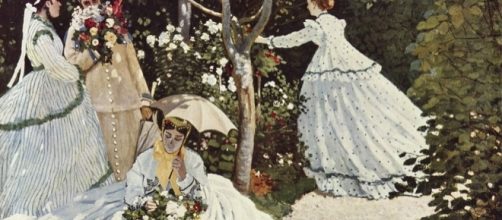Kudos to Allison McNearney, former deputy manager of the Daily Beast, for posting a rarely reported story on the Oct 29 website about how Monet trashed 15 of his iconic water lilies paintings. But except for noting the high standards the artist set for himself, she offered no other insight in her otherwise exhaustive and compelling write-up.
His heart was a garden without walls
McNearney pointed out that Monet loved the garden he created and took inspiration from it for his picture-making. Even when he wasn’t painting flowers, his imagery of, say, billowing dresses in “Women in the Garden” relates to blossoms.
But the way McNearney’s story reads, you’d think he was a madman, oblivious to the world around him, including the exhibit hall owner who waited in vain for delivery of his work. Missing from her story was an event that could explain his self-destructive behavior. (More about that event in a moment).
Totaling his art doesn’t make him crazy
To hear historians tell it, Monet was not a nut. Jean-Pierre Hoschede wrote in his 1960 book about the artist, that he was known to be helpful to everyone - colleagues, relations, local people, and even people he didn’t know, including all beggars who came to his door. In contrast, McNearney shows Monet ignoring neighbors who balked at his lily pond because he re-routed a river for it.
While I don’t doubt her research, mentioning this incident seemed unnecessary since nothing came of it.
The question that went unasked, unanswered
Meanwhile, the fact that Monet sabotaged his work was the constant reality in McNearney’s story and it went pleading for an explanation that never came. By chance, though, she set up the perfect segway to the answer when she wrote, “Nothing could stop the realization of his vision for his outdoor paradise—not nature, not cost.” But something did happen to stop him from picturing his paradise.
According to Marthe de Fels’ 1925 book “La Vie de Claude Monet,” the reason why begins with the trees in his garden, which reportedly meant the world to him. Fels called them his “great friends” that he talked with every morning. Hold that thought.
A logical explanation
As Fels tells it, Monet’s friend, M. Raymond Koechlin, saw him in his garden one morning with a sad expression pacing up and down “like an animal at bay.” After refusing to say what was bothering him, he got around to explaining that a storm felled his two “great friends.” “You understand?” Monet asked his friend.
“Two trees! It isn’t my garden anymore!” and he went back to pacing, muttering, “It isn’t my garden anymore! It isn’t my garden!” Since the source of his inspiration was ruined, it follows that the paintings must also be ruined, no?


